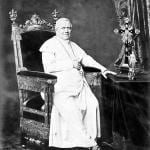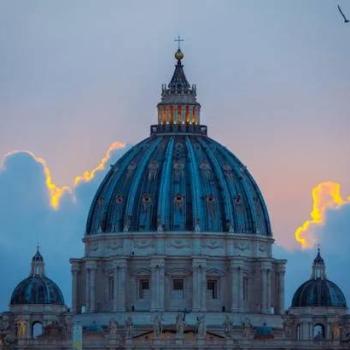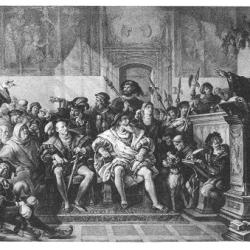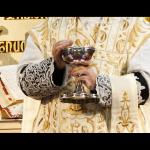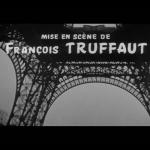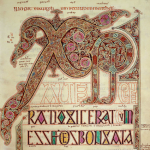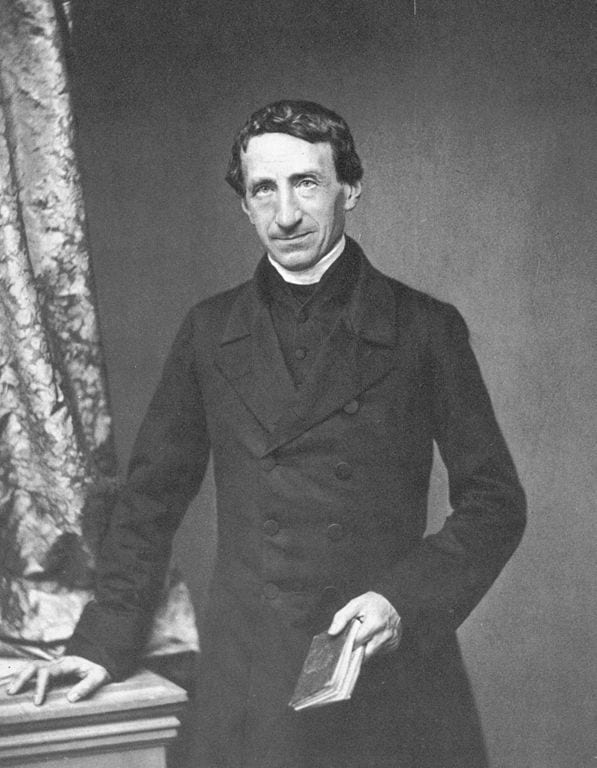
Dr. Peter Kwasniewski is a radical Catholic reactionary writer and speaker. His words will be in blue.
*****
“What shall we do about Vatican I?” This past Sunday, December 8, marked the 150th anniversary of the opening of a council that would forever change the way Catholics perceived and interacted with the papacy — the impetus for a runaway hyperpapalism capable of leveling centuries of tradition. In many ways, we are more threatened today by the spirit of Vatican I, which it will take a mighty exorcism to drive away. (“The Second Vatican Council Is Now Far Spent,” One Peter Five, 12-11-19)
This is a remarkable and striking development within the reactionary movement, but it’s also quite predictable if one ponders it a bit, as I shall argue below. People usually think consistently within their own paradigm, so that if they go down one wrong road, they will also go down several more that flow from the same false premise(s). I’ve been making two related points for many years now:
1) If a person habitually bashes and trashes a sitting pope (which Catholics by nature ought not do), then he or she will start bashing other popes besides the current one, as well.
2) If a person habitually bashes and trashes popes, then by the same “diabolical logic” he or she will start trashing the other (and most recent) largest source of authority in the extraordinary magisterium: the Second Vatican Council (1962-1965).
We’ve seen both of these tendencies come to pass before our eyes, in the increasing bashing of Popes Benedict XVI and St. John Paul II and St. Paul VI in particular (even among those who are not reactionaries: just so-called “conservative” Catholics), and also St. John XXIII: in other words, all of the “post-Vatican II popes.” I won’t even document instances here. They can be found on my Traditionalists & Reactionaries page and Papacy & Infallibility page (search their names), and on my Church page (search Vatican II); also in my collection of defenses of Pope Francis (now numbering 181).
Now this new element is starting to creep in, and it makes sense, once the quasi-schismatic and anti-authoritarian nature of the reactionary mindset is properly and fully understood. It’s a Luther-like (i.e., Protestant-like) and liberal Catholic-like aversion to binding Church authority, in the form of popes and councils. Holy Mother Church teaches us that these are infallible, generally speaking: lots of complexities and nuances in the application.
But those who champ at the bit against authority willfully rebelled against popes and councils. Luther made it a plank of his entire revolution that they contradicted themselves, hence, were not infallible, and — following the logic through — were therefore not in the final analysis part of the rule of faith. Only Scripture was a final and infallible guide (sola Scriptura). That was actually the biggest sea-change of the Protestant Revolt: far more than faith alone / sola fide (because Catholicism actually agreed far more with Protestants on grace and justification and soteriology, than they realized.
Liberal and nominal Catholics think similarly, since in their tragic lack of supernatural faith they disavow both an inspired Scripture and infallible popes and councils. They dismissed Vatican II by simply — cleverly — talking more about its supposed “spirit” than its actual documents and complete continuity with existing Catholic tradition. Orthodoxy accepts the authority of ecumenical councils, but only the first seven; then it arbitrarily dismisses any others past that time (the eighth century). And of course, it rejects papal supremacy and infallibility, granting the bishop of Rome only a more or less egalitarian “primacy of honor.”
So we see the spectacle now of reactionaries deliberately trashing and undermining the authority, not just of Vatican Two, but of Vatican One (1870). They have a motive to go after it (rather than the still sacred and unimpeachable Trent, in their eyes), because it specifically defined papal infallibility. Now, when that occurred, it meant that there was relatively more authority residing in the papacy, and since they tend to dislike papal authority, this would then become a “negative” thing in their eyes.
But in fact, it really changed little or nothing, because, like all doctrinal developments, the proclamation of papal infallibility only dogmatized at the highest level what was already very extensively understood and practiced for many centuries, and in kernel form, from the very beginning of the Church.
The other thing that would bother a reactionary about Vatican I is the fact that its decree on papal infallibility (Pastor aeternus) also made explicit and clear — here is its most egregious error or “trend-setting” mark in their eyes — that popes cannot fall into heresy (i.e., papal indefectibility); certainly not, particularly, in the sense of proclaiming heresies to be truths and binding Catholics to them. I now have two (I think, very important in their topic) articles about this on my blog:
Pastor Aeternus (1870): Can a Pope Ever Make Heresy Binding? (Dr. Robert Fastiggi and Ron Conte; edited by Dave Armstrong, in Response to Timothy Flanders) [12-1-20]
If a pope can’t fall into or teach heresy (so dogmatized Vatican I), then this virtually makes a mockery of the massive currently fashionable bandwagon of trashing and questioning Pope Francis at every turn, doesn’t it? It’s like the dramatic removal of the entire limb that the bashers are sitting way out on, in the giant “tree” of the anti-Francis movement. Once it’s removed, they all come crashing down, along with their false notions and slanders of the pope: complaining and wailing all the way down.
So they must now find a way to start undermining and trashing Vatican I. And so what does quintessential reactionary Dr. Kwasniewski do? He starts talking about the odious, reprehensible “spirit of Vatican I” (his exact words!), which “will take a mighty exorcism to drive away.” He even shamelessly threw in other councils, too, in his disdainful, most un-Catholic dismissal of conciliar authority:
I suggest we leave it [Vatican II] alone, leave it behind, leave it in peace, along with Lyons I, Lateran V, and other councils you’ve never heard of, and turn our minds and hands to better things ahead . . .
We must, then, add a third defining element to the current sad, pathetic development of reactionary error and rebellion against Holy Mother Church and Sacred Tradition:
3) If a reactionary habitually bashes and trashes the Second Vatican Council, then they will also go on to trash other councils: above all, Vatican I, since it made dogma the truth that popes can never be heretics, which undermines and demolishes the entire papal-bashing premise and primary outward characteristic — and arguably the essence — of the radical Catholic reactionary outlook.
The reactionaries even have an historical model of rejection of Vatican I that they can draw inspiration from: German hyper-rationalist historian Johann Joseph Ignaz von Döllinger, who outright rejected the decree on papal infallibility, and was excommunicated. He went on to head the schismatic breakaway group called “Old Catholics”, which had precursors going back to the 16th century. It continues on today, with membership of about 115,000.
By the way, here are some of the current beliefs of the “Old Catholic Church”: which supposedly was dedicated to preserving apostolic tradition in its entirety, over against the alleged unacceptable “innovations” of Vatican I:
Christ-Catholic Swiss bishop Urs Küry dismissed the Catholic dogma of transubstantiation because this Scholastic interpretation presumes to explain the Eucharist using the metaphysical concept of “substance”. Like the Orthodox approach to the Eucharist, Old Catholics, he says, ought to accept an unexplainable divine mystery as such and should not cleave to or insist upon a particular theory of the sacrament. Because of this approach, Old Catholics hold an open view to most issues, including the role of women in the Church, the role of married people within ordained ministry, the morality of same sex relationships, the use of conscience when deciding whether to use artificial contraception, and liturgical reforms such as open communion. Its liturgy has not significantly departed from the Tridentine Mass, as is shown in the translation of the German altar book (missal).
In 1994 the German bishops decided to ordain women as priests, and put this into practice on 27 May 1996. Similar decisions and practices followed in Austria, Switzerland and the Netherlands. In 2020, the Swiss church also voted in favour of same-sex marriage. Marriages between two men and two women will be conducted in the same manner as heterosexual marriages. The UU allows those who are divorced to have a new marriage in the church, and has no particular teaching on abortion, leaving such decisions to the married couple. (Wikipedia)
There you have it, folks: pure liberal Protestantism; basically liberal Episcopalianism with Tridentine liturgy to make it falsely appear as “traditional.” Yet in a gathering in Munich in 1871, the stated goals of the schism were, among other things, “adherence to the ancient Catholic faith” and “rejection of new Catholic dogmas.” We see how well they have preserved those worthy goals. My, how things change, huh?
Yesterday I critiqued a pitiful attempt by Dr. Kwasniewski (who edited a book of Newman quotations last year) to enlist St. John Henry Cardinal Newman as a fellow enemy of Vatican I. He miserably failed, and it was an exercise of sophistry from A to Z. It was Newman who excoriated and refuted the grave and wrongheaded hyper-rationalistic errors of Döllinger and explicated exactly how and why he had gone off the tracks. Reactionaries today are following Döllinger’s lead, not Newman’s. Newman fully accepted Vatican I and papal infallibility as a highest-level dogma: since he had accepted papal infallibility even as an Anglican, and very firmly since his reception into the Church in 1845.
On a humorous note, I just discovered that I was mentioned in the same article:
Those who broach such issues are not engaged in a serious way, but are written off as “radical Catholic reactionaries” whom everyone should be strong-armed — or Armstronged? — to avoid like the plague. I suppose that’s one way to deal with uncomfortable truths, but it’s not recommended for those seeking the real causes of today’s crisis.
This is ridiculously laughable. I just finished my seventh installment of an ongoing dialogue with Timothy Flanders, who regularly writes for One Peter Five, where this article of Dr. Kwasniewski’s was published, and who is an associate of Taylor Marshall. We have gotten along with perfect cordiality, finding a fair degree of common ground as we communicate back and forth and listen to each other. I have a great deal of personal respect for him. Yet he basically holds the same views as Dr. Kwasniewski. He’s simply willing to dialogue about them and make common ground with non-traditionalist, passionately orthodox Catholics like myself (one who feels a great affinity to many emphases and beliefs of traditionalists). I think it’s a fabulous and constructive dialogue: one of my favorites I’ve ever been in (and I’ve been involved in well over a thousand by now, in 23 years of constant online apologetics, and another 16 years of apologetics before that).
Because of the almost complete unwillingness of reactionaries to dialogue, I’m banned at The Remnant and One Peter Five and Lifesite News. Steve Skojec treats me with the utmost contempt and mockery. Dialogue? What a joke . . . Taylor Marshall immediately banned me from his Twitter page as soon as I dared disagree with his book, even though he had highly recommended my work for years, and even carried an ad for it for several years on his site. Anytime you wanna talk, Taylor, I’m here . . . Phil Lawler, whose pope-trashing book I have critiqued (though I don’t classify him as a reactionary), engaged in very brief discussion with me, then decided he shouldn’t continue, and falsely accused me of absurd things that never happened. Chris Ferrara and Michael Matt at The Remnant treat me with dripping disdain and wholesale mockery.
Dr. Janet Smith, who has become increasingly reactionary in the last few years, wasn’t willing to dialogue with me about it. I appeared on her Facebook page a few times, but she quickly became hostile and personally insulting and made it clear I was no longer welcome. So I split. Takes two . . . Dr. Eduardo Echeverria first wrote to me regarding his recent book, where he turned against Pope Francis, asking if I’d like to review it (I had reviewed his earlier, pro-Francis version). I said I’d rather engage in public dialogue. He had no interest in that, and only wanted to chat in a restaurant, which is fine — and the exchange was at least cordial — , but I also wanted to have a serious dialogue in public, too. Again, takes two . . . Timothy Gordon commented on my blog after I noted that Taylor Marshall had cast him to the wind, and seemed to be open to dialogue, which I said I was quite pleased to enter into. I followed up several times but nothing has happened. Maybe Dr. Kwasniewski got to him and advised him to avoid me like the plague.
Need I go on with the endless examples? That’s eleven altogether typical ones, and Dr. Kwasniewski himself makes it a dirty dozen. At every turn, it seems, reactionaries — usually self-described as “traditionalists” — (with the very notable and refreshing exception of Timothy Flanders), are unwilling to engage in dialogue. This includes Dr. Kwasniewski, who used to dialogue with me (and I always thought that he was personally a friendly guy): who has no interest anymore to talk to me at all. Yet here he is accusing me of being the one unwilling to interact and talk. It’s the exact opposite of the truth. I’m here anytime he (or any other anti-Francis, anti-Vatican II — and I — reactionary) wants to defend his dubious viewpoints: regarding this article or my last one or any other. Bring it on! But, dear reader, don’t hold your breath waiting for him to do so. I would say it’s about as likely as the Second Coming taking place next week.
Along these lines, Fr. Longenecker still believes in the “hermeneutic of continuity” between the premodern Church and the Church of Vatican II. This hermeneutic died when Pope Benedict resigned. That act of abandoning the flock to the wolves symbolized the practical and theoretical abandonment of this vision of harmony (“if only we could just read what the 16 documents actually say!”) and its replacement by the more sober realization that the Council chose accommodation to the mind and modes of modernity over clear continuity with tradition. We are now reaping the rotten fruits of that choice. [my bolding; Pope Benedict is a bum and a liar, to boot . . . ]
We can see, moreover, the full magnitude of the evils that remained in the Church in spite of, and at times because of, John Paul II and Benedict XVI, . . . [gotta get St. John Paul in there too: with the obligatory non-use of “St.”!]
Remember what I wrote above about the reactionaries going after other popes prior to Francis? . . . this is textbook.
The architects of the Council, who, lucky for us, wrote and spoke freely about their intentions, were trying rather to domesticate the Modernism of the 19th and early 20th centuries, to make it mainstream and acceptable . . .
That is, Vatican II was flat-out modernist . . .
There’s a lot more untrue slop in this article. I don’t have the patience to address all of it at the moment (I’m a human being, and not an infinitely patient one).
But mark my words: the reactionary mindset / mentality / movement has now moved beyond Pope Francis-bashing to the bashing of all popes since St. John XXIII: which has great similarities to the position (in this regard) of the sedevacantists and SSPX. They’ve moved beyond Vatican II-bashing, to Vatican I bashing: because the latter, in its declaration on papal infallibility and indefectibility, most assuredly doesn’t fit in with its agenda, and so must be discarded (or, more subtly and cleverly, ignored or minimized).
It just keeps getting worse and worse. And as it does, and as some of you now skeptical of my opinions begin to accept them, due to actual events and opinions rendered, please remember me in your prayers and realize that I tried to warn you (and the larger Church) about this, and analyze it, when very few others were willing to do so.
I predicted that they would start trashing Pope Benedict XVI, their former darling and “savior.” They did. Now it’s quite “fashionable” in their ranks. I predicted that they would increasingly go after Vatican II. They did (now we have bishops Vigano and Schneider expressly disavowing it). I didn’t predict this current urge to also diss Vatican I, but it fits the pattern perfectly (I see that clearly now) and I have laid it bare in this paper for all to see. Stay tuned: it will get worse (I do predict that), in all these tendencies. Once one goes down a wrong theological / spiritual path, it never gets better short of a full repentance and reversal. Pray for all these people, and pray for the millions who are, — or will be in the future –, tragically misled and extensively harmed by them.
***
Follow-Up Reading
Peter Kwasniewski vs. Papal Authority (Ron Conte, The Reproach of Christ, 8-3-21)
***
Photo credit: Joseph Ignaz von Döllinger (1799-1890) [public domain / Wikimedia Commons]
***


